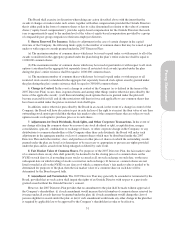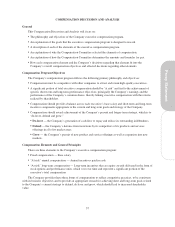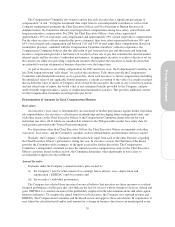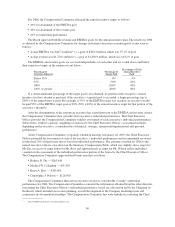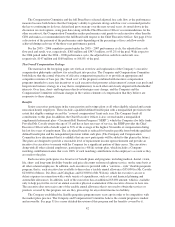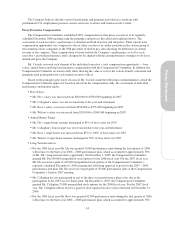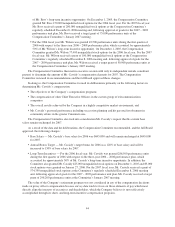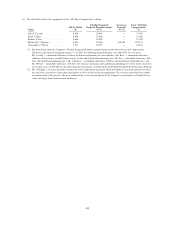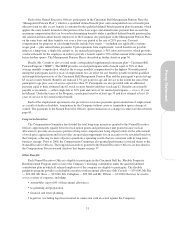Cincinnati Bell 2006 Annual Report Download - page 53
Download and view the complete annual report
Please find page 53 of the 2006 Cincinnati Bell annual report below. You can navigate through the pages in the report by either clicking on the pages listed below, or by using the keyword search tool below to find specific information within the annual report.
Executive Officer’s performance and may recommend to the full Board a discretionary increase or decrease to
the Chief Executive Officer’s final incentive award as the Compensation Committee believes is warranted. The
Compensation Committee recommended to the full Board that Mr. Cassidy be awarded a bonus for 2006 of
$887,004, which was above Mr. Cassidy’s target bonus for 2006. The above target bonus reflects the level of
attainment against the Revenue and EBITDA goals set and the Compensation Committee’s and full Board’s
assessment of Mr. Cassidy’s individual performance during the year. The full Board approved the award.
Long-term incentives
Long-term incentives are intended to emphasize that the Company’s executives need to focus on and
achieve the long-term business goals of the Company. Additionally, long-term incentive awards also aid the
development and retention of top management through share ownership and recognition of future performance.
An executive’s realization of his/her long-term incentive means that the Company has also performed in
accordance with plan over a long-term period.
The Company’s long-term incentives consist principally of stock options and performance-based awards
granted under the Company’s long-term incentive plan. The Compensation Committee has divided the total long-
term incentives approximately equally between stock option grants and performance unit grants because such an
allocation enables the Company to compensate executive management based upon a combination of stock price
appreciation and operating results that are consistent with its long-term business strategy. Stock options directly
align the executive’s interest with the shareholders’ interest because any actual realized value derived from stock
options requires appreciation in the Company stock price, whereas performance units vest and are convertible
into common stock based upon the attainment of specific objectives. Gains from prior awards, in the Company’s
and Compensation Committee’s view, have been relatively modest and were not a factor in setting long-term
incentive grants in 2006. Additionally, long-term incentives are not included in the Company’s retirement
program for any purpose, including calculating any retirement benefits the executive may be entitled to when he
or she leaves the employ of the Company.
Stock options
The Company grants stock options at the fair market value of the Company’s common shares on the date of
grant, which are outstanding for a ten year period. The “fair market value” of the Company’s common shares on
the date of grant is defined in its 1997 Long Term Incentive Plan as the average of the high and low traded price
of the stock on the NYSE on the date of grant. The Compensation Committee has a long-standing practice of
making its annual grants of stock options at their December meeting.
The Compensation Committee (and in the case of the Chief Executive Officer, the full Board) grants stock
option awards based upon a review of peer company practices and each executive’s performance (as well as the
Chief Executive Officer’s recommendations concerning the other executives). To incent the executives to
achieve the Company’s long-term goals, the awards vest over a three-year period with a percentage of the award
vesting each year. The Compensation Committee noted that prior grants have exercise prices approximating this
year’s grants, and, therefore, the prior grants had no material effect on the grant amounts awarded this year since
equity appreciation from earlier grants has been very modest.
Performance Plan
Performance-based awards, which are paid in shares of common stock, are based on the achievement of
specific Company quantitative goals over a three-year performance period. They are granted during the first
quarter of each calendar year following finalization and approval by the full Board of the one-year, two-year
cumulative and cumulative three-year financial goal(s) for the next three-year period. For the 2005 – 2007
(which target awards were made as restricted shares) and 2006 – 2008 periods (which target awards were made
as performance units), the Compensation Committee (and the full Board in the case of the Chief Executive
Officer) established a criterion of adjusted free cash flow. To compute each executive’s performance plan
attainment, the Company adds to or subtracts from reported free cash flow certain pre-established, non-recurring,
investment and financing cash flows, which include items such as financing proceeds and related fees,
acquisitions, divestitures, and capital expenditures that are less than the Company’s budgeted amount.
Additionally, the Compensation Committee or Board may also adjust this amount for unanticipated items or
changes in certain business objectives.
41
Proxy Statement


